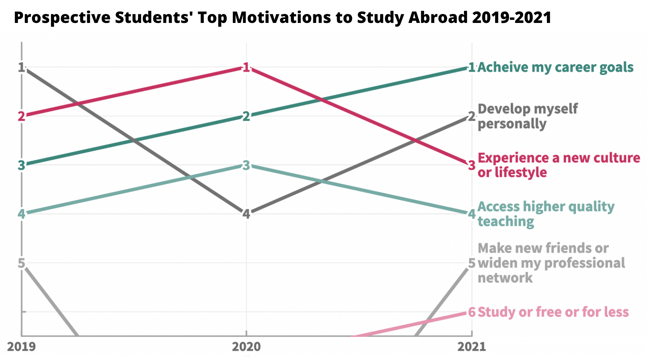Our study abroad survey collected responses from over 10,000 prospective students across 181 countries this year. Using our previous survey data, we’ve highlighted the most striking global trends in this report to give you insight into how the international student market is changing in 2021.
Access our Regional Student Trends reports for detailed trend analyses of prospective student data in 7 global regions, and view our fully customizable Student Insights 2021-2022 dashboard to see the entirety of this year’s survey data.
1. South Korea rises by leaps and bounds while Australia plummets
The popularity of the UK as a study abroad destination continues to drop each year, while the US holds steady at around 14% of students in this year’s and last year’s survey. This is still a huge drop from it’s supremacy as an overseas study destination in 2019 (21%). Canada has made the largest gains in the top three this year. In this part of North America, there’s been a 10% growth in student interest from last year and a 14% increase from the year before.
Canada’s rising popularity pales beside the rise of South Korea this year. Perhaps driven by the South Korean government’s ambitious Study in Korea initiative, including an increased number of English-taught programs at Korean universities, international student interest in Korea as a study abroad destination has skyrocketed. Since last year, more than double the proportion of prospective international students surveyed say they want to study abroad here, and more than triple that of 2019. The destination grew in popularity by double in the United States since 2019, and more than quadrupled in Asia.
Australia has suffered the most this year, especially as border closures are only more recently opening up for international students from long-lasting pandemic closures. With most of Australia’s international student population coming from Asia, it’s shocking that Asian student interest has dropped by 35% since 2019. Along with heightened attention to studying in Korea, Japan has also grown significantly in popularity for Asian students - a 71% increase from 2019.
Will the Australian international education market recover once borders reopen, or will students be turning towards more non-English speaking countries for their studies?
2. Student safety concerns high
As many prospective international students are looking towards first-time opportunities of living abroad, it’s crucial to have a multi-dimensional understanding of their anxieties in the thought process - including their worries about safety. This year, only 15% of all prospective students indicated they have no concerns with safety when heading abroad, leaving 85% with significant concerns globally.
These numbers are overwhelmingly large in Africa and Asia. Across Africa, 91% say they are concerned about their safety when thinking about studying abroad, with 60% of that percentage citing racial discrimination as their biggest source of unease. Proportions of apprehensive students are even higher In Asia. With 93% indicating safety concerns, 26% of this group of Asian students are thinking about potential racial discrimination, and 25% are worried about Asian-hate abroad.
The rise of xenophobia towards international students in popular host countries like the United States and Australia is not unnoticed by prospective students. Creating safe spaces and providing robust student support will be increasingly crucial for international students looking for friendly, multicultural environments during their studies away from home.
3. Career paths a big focus

As the pandemic continues to shape international student decision-making, finding job security in the face of economic uncertainty has become more of a priority than ever. International students from around the world have made huge leaps in focus of how their degree will place them in the workforce. Achieving career goals has become the top motivation for students looking to study abroad overall, with the highest percentage prioritizing this factor in the regional area of the Middle East, Caucasia, and Central Asia (54%).
When looking at the most important aspects of a program, 70% more European students prioritize graduate career prospects as a top program factor this year than last. Particular regions of Asia are also looking towards their future career path. Southeast Asia and South Asia saw a 26% increase since 2020 in the proportion of students valuing graduate career prospects in a program the most.
4. Mental health has become increasingly important
Connected to the heightened safety concerns and anxieties about future jobs is mental health. More attention is being paid to the mental well-being of international students, especially as the world continues to adjust to new global realities.
When comparing with our previous survey looking at mental health in 2020, there is little change in the proportion of students who are not considering the importance of mental health support services when deciding on a university. There is, however, a shift in those who do prioritize the importance of these services when making decisions.
Compared to last year, there’s been a 14% increase in the percentage of students who say that a university’s mental health support services are very important. Though the overall proportion of students who see this as important is nearly the same, it’s also clear that mental health services are only becoming more essential for international students around the world.
5. YouTube plummets - Instagram reigns king
In 2019, we asked prospective students from around the world how important different social media platforms were to them when researching study abroad options. Two years ago, YouTube was the resounding winner across the board. This year, Instagram claims the top spot as the most helpful social media platform when looking for information about a university. Though Facebook has dropped to be the preferred platform for only 10% of students in North America, Facebook still overtakes Instagram in Africa with 31% of students.
With over a billion users and a push towards more advertising opportunities, TikTok shouldn’t be ignored. Already, 2% of North Americans and 3% of Oceanic students prefer this app for learning more about universities. We can surmise that this number will grow even larger in the coming years.
6. Schools growing in importance, Country dropping as a first priority
Around the world, double the percentage of prospective students this year are looking at the school as a first consideration when decision-making as compared to 2019’s numbers. African, European, and Asian students are especially more interested in looking at the institution first since 2019, with an increase of 133%, 96%, and 93% respectively. Students from Oceania are a notable exception. Here, the proportion of students considering the school first has decreased by half in the same time period.
The study abroad country is diminishing in favor of other factors as a first consideration in several regions. The country has decreased in importance over the last two years in Latin America by 38%, in Europe by 34%, and by 25% in North America.
Though there’s been a slight drop worldwide, the program became more often a first priority in decision-making in North America, Europe, Oceania, and Latin America. Growth levels shot up especially high in Oceania and Latin America over the last few years, where 59% and 21% more students respectively say that finding the right program is the most important when decision-making.
7. Students are divided on whether they want a flexible study mode or face-to-face campus instruction
When asked about preferred class mode, there is one thing for sure - most students are not looking for completely online learning experiences when studying abroad. More surprisingly, 43% prefer blended learning, or a mix between online and in-person classes.
In this year’s survey, we asked students who prioritize the program as a first consideration what is most important in a program. We found that the study mode and flexibility of a course have double the importance to American students (42%) than for Canadians (20%). In addition, we saw that on-campus delivery is almost four times more crucial for South Asians since last year as a decision-making factor when looking at study abroad programs (24%). In-person delivery as a program factor was also chosen more often this year in Europe by more than double, demonstrating an education landscape affected by the pandemic.
Though students still seem to turn away from programs that are completely online, it's possible that mixed-mode delivery could be here to stay.
8. Peer-to-Peer continues to be very influential
The weight of peer-to-peer communication is hard to ignore. This year, 63% of prospective students said that they want to talk to international students at the school before applying to a university. Compared to only 17% that want to talk to the alumni of a program or university, these statistics indicate the importance of student ambassadors who are currently studying abroad.
In another survey question this year, 39% of prospective students cited student stories of studying abroad as a most helpful factor when deciding where to study. Student stories hold even more influence than the global average in Oceania (56%), North America (52%), and Europe (47%).
Noting students’ increased preferences towards more personal communication is paramount. Peer-to-peer signals a desire for prospective students to hear about the international student experience from someone that they authentically relate to.
9. When students plan to go abroad for their studies varies heavily by region
Looking at the student journey reveals lengthening planning periods in all areas but to different extents. In Southeast Asia, 80% more students are planning to study abroad four or more years in advance than in 2020. Also since last year, there are more than twice as many African students planning one year in advance, and huge jumps in the proportions of students from Latin America, the Middle East, Caucasia, and Central Asia planning one year in advance as well.
It’s difficult to predict student mobility at this time, and when students will freely flow around the world again is anyone’s guess. What is comforting to see is the heavy tilt towards planning one year in advance. As the student journey has been getting longer since 2019 overall, it will be interesting to observe how the scale will tilt once students are no longer restricted by travel limitations. Will the student journey continue on the longer side? Or will things become more balanced?
10. Concerns in the pandemic vary heavily by region
While students will always have certain worries to overcome when they are making a decision on an international program, the pandemic has blurred the lines between the concerns we expect to see and what has emerged due to the virus. So, what are students’ newer pandemic-related concerns? The responses to this survey question brought out significant differences within global regions.
Worries about travel entry to their country of choice reach over half of students in Oceania and Africa (59%). Oceanic students are the most concerned with staying focused and motivated for their studies (35%), and African students have the highest proportion of students anxious about teaching flexibility (13%) and the recognition of online qualifications (13%). Students from Asia are alo highly worried about online qualification recognition (12%) as well as time differences in online programs (18%).
Limited cultural opportunities are at the front of nearly half of prospective students’ minds in North America (48%) and Latin America (47%). Europeans, however, are the group most concerned about their social life and interactions with classmates (42%) when thinking about studying overseas. Europe also has the highest numbers worried about understanding course material in an online format (30%).
The world is an uncertain place, and an international education may be a big leap for some. Yet, with the right information and enough support, we can help these students along to their dream study abroad program in no time.





%20-%202.png)

